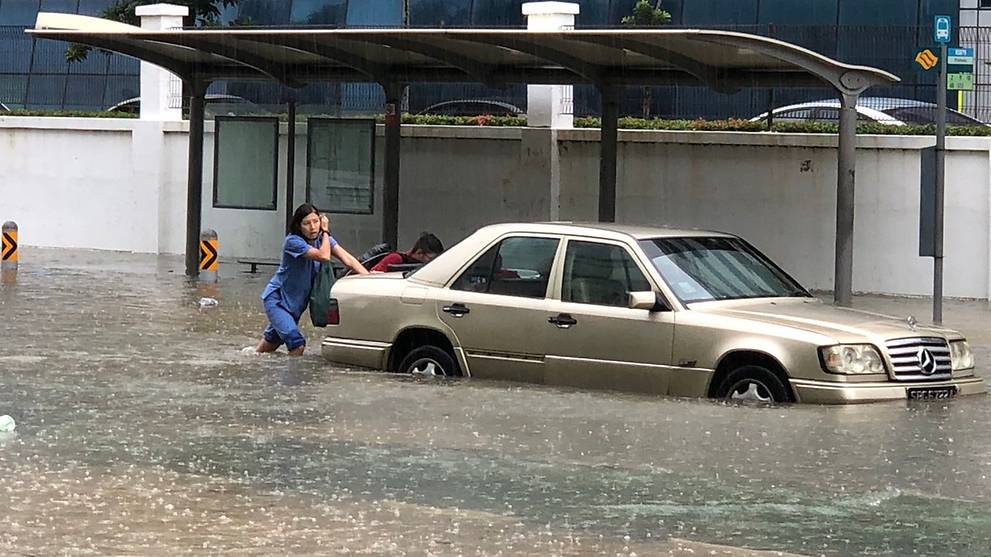How to Protect Your Car During a Flash Flood
Singapore, a fine city known for her cleanliness, good food and the chewing gum ban. Tourists love the weather here but some Singaporeans might tell you otherwise. You can expect a flood of complaints when you talk about the weather.
Due to the country’s tropical climate, the weather is either wet or dry and can be quite erratic. It could be blistering hot in the morning and raining cats and dogs in the afternoon. We’re pretty much used to this erratic climate, maybe too used to it.
Flash Floods Occur All the Time
In a number of occasions, the heavy rain has even caused flash floods to occur throughout the island. When this happens, the sensible thing to do is stay indoors when there’s really really heavy rain.
But what if you’re already out and stuck in heavy rain, potentially facing a flash flood?

When this happens, driving is extremely dangerous as you might damage the parts in your car. If the water level gets too high, it’s very common to see cars break down and getting stuck in the middle of the road. So, always be extra careful when driving during a flash flood!
If you find yourself in this unfortunate scenario, here’s what you should do.
Get High!
If you think that the water’s rising, find higher ground. On an occasion where you find yourself facing a flooded area, don’t be a hero and drive through it (we know it’s fun to do, but please don’t).
Stay Centred
If you’re feeling bold and decide to drive through the flooded area, try your best to drive in the middle of the road. Known as the crown of the road, the middle area is usually the shallowest and slightly elevated. Which lowers the chances of any water seeping through and potentially damaging your car.
Go Slow & Steady
Your visibility is at a minimum during a downpour, which clouds your judgement of how deep the floods are. Take precautions when driving during heavy rain or a flash flood to protect your car from getting damaged by the water.
Always drive slowly and safely. The risk of stalling is extremely high during a flood. All your engine needs is to suck a little water, and it could stall. And arguably the most expensive component in a car, engines can cost you thousands (if not tens of thousands) of dollars to fix.
Rev It Up
When entering the water, go extremely slow and start revving. Going in hard and fast might cause the tyres to lose traction. And subsequently, lose control of the car.
To ensure water doesn’t get sucked into the exhaust, keep on revving! It’ll blow out access water that might seep into the exhaust pipes.
Dry Up
Remember to dry your brakes! Brakes will lose its efficiency when wet and could pose a major safety issue. To dry them, you have to heat them up. To do this, apply light intermittent braking for a couple of kilometres.
What Next?
The uncertainties of flash floods mean it can happen anytime. So what do you do if your parked car was caught in one? Follow these steps to ensure your car is safe to drive and free from damage.
Don’t Start First
Whenever you want to check if something is working, the most natural thing to do is to turn it on. But for the sake of your car, please don’t! Why? Because if there’s water in your engine, starting it up will damage it beyond repair.
The first thing you should do is estimate the depth of the flood. This will aid in your judgement of whether starting up the car is a smart thing to do. Due to mud and debris, there should be a waterline on your car. As a basic guide, if the waterline doesn’t go above the base of your doors, it should be fine to start it up.
Check The Liquids

It is essential you do thorough checks on all the liquids in your car. Especially the engine oil, transmission fluid and air filter. If any of these liquids seem diluted, you must get your car to a trusted workshop and get it fixed.
It’s always better to be safe than sorry. If you’re unsure of the water damage, just call for a towing service.
People also liked: ALL YOU NEED TO KNOW ABOUT INSPECTION TO RENEW ROAD TAX IN SINGAPORE SAY HELLO TO PREMIUM MOBILITY SERVICES COOLEST CAR FEATURES TO SHOW OFF DURING CHINESE NEW YEAR





